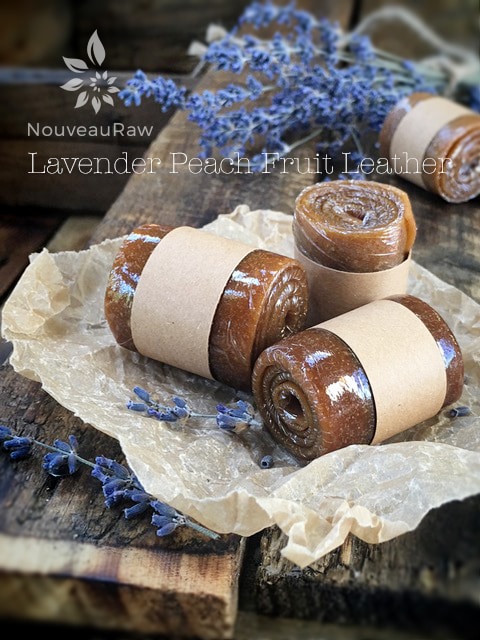Lavender Peach Fruit Leather

 Add to favorites
Add to favorites

~ raw, vegan, gluten-free, nut-free ~
Lavender – Delicate, floral, with lemon and citrus notes, is a good way to describe the taste of lavender. I am just amazed as to how beautiful this delicate flavor balanced so well with the peach. A real match made in heaven, or at least in the Oldfather Farm Kitchen.
You can use the flowers, leaves, or stems. I like to use the delicate buds because the taste of the leaves and stems are stronger and can be bitter. The key to cooking with lavender is to experiment; start out with a small amount and add more as you go.
As in all herbs, the dried is more concentrated in flavor. Always start with a small amount than you might expect and work the flavor profile up to your liking. If you add too much, it can taste like perfume, and there isn’t much you can do to save the recipe.
Chopping or bruising the buds will help release the flavor. Chopping can be done easily in a food processor, coffee grinder, or spice grinder. If you use a grinder, you may need to add enough volume of flower buds to avoid a purple tornado that just spins and spins, thus not breaking down. I did a couple of tablespoons at a time and stored it in a dark glass jar out of the light.
Ingredients:
yields 4 cups of puree
- 5 cups chopped peaches
- 1 Tbsp pure maple syrup
- 1/2 tsp fresh ground lavender
Preparation:
- Select RIPE or slightly overripe peaches that have reached a peak in color, texture, and flavor.
- Prepare the peaches; wash, dry, remove stems, and stones.
- In a spice grinder, grind the lavender buds until they reach a powdery consistency.
- Puree the fruit, maple syrup, and lavender in the blender or food processor until smooth.
- Taste and sweeten more if needed. Keep in mind that flavors will intensify as they dehydrate.
- When adding a sweetener do so a little at a time, and reblend, tasting until it is at the desired taste.
- It is best to use a liquid type sweetener. Don’t use granulated sugar because it tends to change the texture of the finished fruit leather.
- Spread the fruit puree on teflex sheets that come with your dehydrator. Pour the puree to create an even depth of 1/8 to 1/4 inch. If you don’t have teflex sheets for the trays, you can line your trays with plastic wrap or parchment paper. Do not use wax paper or aluminum foil.
- Lightly coat the food dehydrator plastic sheets or wrap with a cooking spray, I use coconut oil that comes in a spray.
- When spreading the puree on the liner, allow about an inch of space between the mixture and the outside edge. The fruit leather mixture will spread out as it dries, so it needs a little room to allow for this expansion.
- Be sure to spread the puree evenly on your drying tray. When spreading the puree mixture, try tilting and shaking the tray to help it distribute more evenly. Also, it is a good idea to rotate your trays throughout the drying period. This will help assure that the leathers dry evenly.
- Dehydrate the fruit leather at 145 degrees (F) for 1 hour, reduce temp to 115 degrees (F) and continue drying for about 16 (+/-) hours. Flip the leather over about halfway through, remove the teflex sheet, and continue drying on the mesh sheet. The finished consistency should be pliable and easy to roll.
- Check for dark spots on top of the fruit leather. If dark spots can be seen it is a sign that it is not completely dry.
- Press down on the fruit leather with a finger. If no indentation is visible or if it is no longer tacky to the touch, the fruit leather is dry and can be removed from the dehydrator.
- Peel the leather from the dehydrator trays or parchment paper. If it peels away easily and holds its shape after peeling, it is dry. If it is still sticking or loses its shape after peeling, it needs further drying.
- Under-dried fruit leather will not keep; it will mold. Over-dried fruit leather will become hard and crack, although it will still be edible and will keep for a long time
- Storage: To store the finished fruit leather…
- Allow the leather to cool before wrapping up to avoid moisture from forming, thus giving it a breeding ground for molds.
- Roll them up and wrap them tightly with plastic wrap. Click (here) to see photos of how I wrap them.
- Place in an air-tight container, and store in a dry, dark place. (Light will cause the fruit leather to discolor.)
- The fruit leather will keep at room temperature for one month, or in a freezer for up to one year.
Culinary Explanations:
- Why do I start the dehydrator at 145 degrees (F)? Click (here) to learn the reason behind this.
- When working with fresh ingredients, it is important to taste test as you build a recipe. Learn why (here).
- Don’t own a dehydrator? Learn how to use your oven (here). I do however truly believe that it is a worthwhile investment. Click (here) to learn what I use.
© AmieSue.com
Tags: Dairy Free, Gluten Free, Nut Free, Refined Sugar Free, Soy Free, sugar free, Vegan



 Add to favorites
Add to favorites